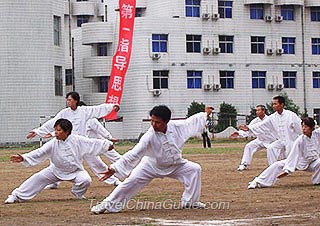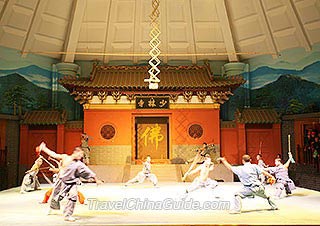History of Chinese Kung Fu
 |
| Chinese Tai Chi Chuan |
Forming
Development
The development of Kung Fu started during the feudal society (221 BC - 1911). After the Emperor Qin Shihuang (259 - 210 BC) unified the central plain of China, the fighting skills among the soldiers gradually developed into Guanzhong Boxing which was called Hong Fist later. Wrestling, fencing, sword dance and sword fighting were popular during the Qin and Han Dynasties (221 BC – 220 AD). For example, Xiang Zhuang, a famous general at that time, played sword at Hongmen Banquet with the intention to kill Liu Bang, who later became the Emperor Gaozu of the Western Han Dynasty (206 BC – 24 AD).
In the Song Dynasty (960 - 1279), at the request of Yue Fei and other patriotic generals, a large number of soldiers and common people tended to practice Kung Fu. It was at that time that Southern Fist (Nanquan) became a popular style taking Hangzhou as the practice center. The Southern Fist mainly emphasized the motions of upper limbs. The movement of elbows and knees was the assistant skills. Later, many similar groups were established to promote the integration of northern and southern martial arts.
 |
| Shaolin Kungfu |
In the Ming Dynasty (1368 - 1644), Long Fist (Changquan), Hong Fist and Kicking Legs appeared with the single and pair practice. The combination of the northern and southern styles composed the Shaolin School Boxing. Qi Jiguang, a famous patriotic general in the Ming Dynasty, compiled all the skills throughout China at that time, including Long Fist, Short Hands, Hong Fist, Bazi Fist and other skills and people called them Southern Shaolin Boxing. Later, Long Fist, Short Hands, Five Fist and Hua Fist of Shandong Province, Five Shapes Boxing and Crane Boxing of Fujian Province as well as the Hung Kuen, Wing Chun and Choy Li Fut of Guangxi and Guangdong provinces became the mainstream during that time.
In the Qing Dynasty (1644 - 1911), Han people were still forbidden to practice Kung Fu in groups and Southern Shaolin Temple gradually declined. The Shaolin Temple at Mt. Songshan in Henan was under strict supervision. Even the monks were not given the right to practice. However, some works on martial arts were widespread in folk circles. During the middle and end of the dynasty, the basic classification of Internal Boxing and external Boxing was formed, whilst the Northern Legs and Southern Fists became well known. After the first Sino-British Opium War in 1840, many folk martial arts groups sprung up to prevent the British army entering Guangdong. Many specific genres including the Form/Intention Boxing (Xingyiquan), Hung Kuen, Southern Shaolin Boxing, Wing Chun and Tai Chi started to be well improved. After 1864, Hung Kuen, including Hua Fist and Eight-Diagram Boxing was introduced to Jiangsu and Zhejiang areas.
During the Republic of China (1912 - 1949), Jingwu Gymnastics Club, the first non-government Kung Fu organization, was established by Huo Yuanjia and Nong Jinsun. Later it developed many branches in Hong Kong, Macau, Singapore, Malaysia, Vietnam and other countries.
Nowadays, China government tends to attach more importance to traditional Chinese Kung Fu which has been compiled as content of courses. Every year many performances and contests are held to encourage civilians to learn and inherit the skills. Various groups or organizations have been founded for better advertising and developing, such as International Martial Arts Federation and Chinese Martial Arts Association. Many schools are correspondingly established to teach all kinds of skills, such as Wudang Sanfeng Martial Arts School and Songshan Shaolin Martial Arts School. Moreover, Chinese Kung Fu has come to the world stage to attract more and more foreign people to enjoy and learn.